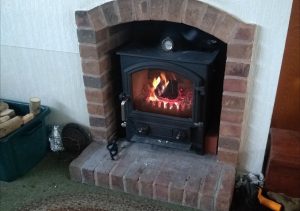
We realise of course that there are certain interests behind the media who are investing a whole lot of money and effort, to discourage and slow the transition away from dependence on gas. Hence someone’s poor experience will get headlines in mainstream media, while all those for whom it works (the majority) will get silence. We are also aware of our son Tim’s experience since fitting a heat pump two years ago, which has been very positive. (I should write an update, as the story gets better.) So, there’s a lot to find out and untangle. We nearly gave up a few times! (This is what happened…)
A very helpful resource for our exploration has been the Facebook group Heat Pumps UK and Ireland. It has been a helpful source of information and discussions, while always being aware that a strongly expressed option doesn’t mean we’re wrong. Another helpful resource has been the Heat Geek channel on YouTube, which explains a lot of the technical decisions in consumer-friendly language, and does experiments exploring different aspects. There have also been a few accounts of personal heat pump experiences such as from the Electric Vehicle Man channel.
What kind of heat pump?
This was an early question. In the UK, radiator systems are already the standard way of heating most homes including ours (we replaced the warm air system with radiators 5 years ago), so the favoured approach is “air-to-water” (A2W) which utilises existing infrastructure and skills. It also easily incorporates water heating. The familiar system but with a different heat source.
Generally speaking, in the USA and in Norway (and probably elsewhere), and also in UK office space, the normal solution is “air-to-air” (A2A). There is an external unit or two, or three, which do the extraction of heat from the air, and then (at least in the UK) each room in the home will have a fan unit or two mounted on the wall near the ceiling, and ducting is run (internally and/or externally) from the pumps to the emitters. They are generally able to both heat and cool a room. However, the water heating needs to have a separate solution.

If you see these warning signs, find another couple companies for quotes.
There are pros and cons with both approaches. A warm air system feels different when you’re used to radiant heat. And if you already have water filled radiators plumbed in, there’s a lot more that just gets thrown away. I won’t go into the details of the choice here, but we did need to consider it. In the end, the layout of our bungalow did not lend itself well to the A2A approach.
There are also ground source heat pumps, but that’s not really practical for our small property. Or a water source heat pump (as we’re by a canal) but after discussion with suppliers that’s not really practical either.
How much will it cost?
A generic price range for a full A2W ASHP installation, including replacement radiators, tends to be around £12,000 – 15,000, give or take a couple thousand. Since the recent increase of government grant from £5000 to £7500 (in October 2023), that makes it not quite so unaffordable. Some disreputable companies have put their prices up to match, but that’s by no means universal – and is a clear flag to who you want to avoid!
Quote 1
So, we start by getting a few quotes. Last year, we had a national energy supplier give us a quote, as they make it so easy online. First they arranged for our Energy Performance Certificate (EPC) to be updated. This describes our 115 square meter property in terms of heat needed to keep warm. Then a surveyor came out, did a Heat Loss Survey (they did not charge for this) and a system design. It was not a satisfactory experience overall, because the resulting report was confused with rooms added or taken away, so we couldn’t trust the information. Terry questioned the factual accuracy with Helpdesk, but didn’t get useful answers. The salesperson pushed us for a decision, and so it was no.
Quote 2
We heard from a few companies via a comparison site. They seemed most keen to sell us a heat loss survey, for £350 or £500 + VAT. Just give us the money and book an appointment. No way! How could we know they were a competent company behind the over-eager sales team, or that their price was sensible? Of course we are going to compare companies! One company was persuaded to send a salesperson (not an engineer) out to us, and was very keen that we should both be present (red flag!). Nice lad who came by public transport because eco things are important to him. He took a quick look around and gave us an estimate. He did let slip that they had taken delivery of a load of 11.5kW heat pumps and needed to shift them… so what do you think the quote was based around? You guessed it! No thanks, wrong approach. I think a comparison site will usually tend to give you this kind of company, who are sales-and-profit led rather than customer service or technical expertise.
Quote 3
Meanwhile (because I happen to enjoy doing floor plans) we prepared a floor plan of our home, with room sizes, window placements, etc. hoping to make it easier for companies to give us an estimate without us paying up front for a heat loss survey. I got in touch with someone on the Heat Geek map (Verified) who wasn’t too far away, to come and look and give us an estimate. He did have a good look around, and had some clear ideas about the ideal design for our home. But it would involve replacing the plastic pipes under the insulated, suspended floor with copper – and suddenly it looked like crazy upheaval and expense, needing to lift floor boards and so on. Hmmm. He didn’t ever get back to us with his estimate, and we didn’t chase him either. It was disappointing, because we value the input we’ve had from the Heat Geek YouTube channel.
Through the Heat Pump group, we were getting an idea of the relative advantages of the different manufacturers, with some scoring more highly on after sales support, or quietness, etc. Also Terry found a couple online tools for estimating heat loss (eg Heat Punk), and working out what rooms needed what size radiators. Not that he wanted to design the system himself, but he had spoken to enough cowboys now to realise it would be better if he had a good understanding. We were also in discussion with our son, who has made a point of understanding and optimising his system, even going so far as to write his own control software.
Quote 4
We approached the company Tim had used for a quote, as he thought it a reasonably competent installation. They are national but have an office not too far from us. I sent them the floor plan and window information, and they came back within a couple days with a ballpark estimate (suggesting an 8kW or 11.4kW heat pump). But because all communication was through the salesperson, we couldn’t get clarification on some technical questions without a site visit they called a “pre installation survey.”
So we arranged for the visit in a few weeks. It went well, the heating engineer appreciated our layout information and checked a few things. It was great to talk things through directly. But when, in due course, the quote and system design came through, we again had technical questions that would get filtered through the sales team, which is frustrating. The presence of a buffer tank seemed questionable, as it’s a small home with no underfloor heating, and are said to reduce efficiency. But it seemed an okay first pass at a design, based on a 7kW heat pump now – more suited to our size home. A definite possibility, now the larger grant was available.
Quote 5
While exploring the different brands of heat pump, Terry looked on the manufacturers’ sites for some local installers, and found a small company that’s quite near – HeatAC in Rugby, two brothers with years of experience in heating and building. We asked them to come over for an estimate, which they did. They also were glad of our floor plan, supplemented with a thorough look around and some sample measurements. They came back to us in a few days with a target range of prices, depending on choice of heat pump brand. If we wanted to go ahead, the next step was a formal heat loss survey, so they know exactly what we need.
Just to note, all the quotes (pre grant) were similar enough so that it was clear we would not be buying on price. What mattered was a) the right design and b) good access to technical discussion and clarification.
Heat loss survey
We decided at this point we really did need to have a complete heat loss survey (whether or not we bought the system from them), and HeatAC had shown themselves technically competent and not extortionate – £250 + VAT for the formal survey. We particularly liked their building experience, to properly understand our non-standard house construction (1970s timber-framed self-build bungalow with modern standard extension) because we knew it could make a difference to the heat loss and therefore to the design. And we liked their willingness to discuss technical details, and how they did not push us into making a decision asap.
So we booked the survey with them a couple weeks later, and Chris and Alex both came around. They did a very thorough heat loss assessment. As potential design obstacles emerged we could discuss ways to work around them. This meant they could come up with some creative solutions, and not just do things in one way because “that’s the way they do it”. They took great pains to get it right, even removing some of the light switches in order to see the wall construction behind, and going under the floor to understand the layout there.
Decision
The design they sent us resulted in the inevitable couple of questions and clarifications, but because Terry was dealing directly with the guys who will do the work, he was able to get good resolutions to his questions, plus a couple tweaks to the final design. They are able to re-use some of the radiators in other locations, to minimise waste without compromising performance. (The heating supplier who installed our gas system five years ago and has serviced it ever since is very interested to have our gas boiler and water tank.)
And so, we’ve done it. We’ve signed the contract and will have the installation on the 8th of January 2024. Why wait? Because we really don’t want to change the heating system just before Christmas, when no one is available over the holidays for any problems that arise. Are we expecting problems? Well, no – not really. We have a lot of confidence in our chosen supplier. But this kind of caution is just how we prefer to work, for the unexpected can still happen.
For those interested in such things, here’s the technical summary of the deal for our 3 bed timber frame bungalow, 114m², EPC B, heat loss 6.1kW at -4°C:
- 7kW Vaillant heat pump
- 6 new rads, 3 re-used in other rooms, and 3 unchanged (only 4 to get rid of)
- 200 litre hot water cylinder with solar iBoost ability retained
- 18 litre volumiser to help ensure effective defrost cycles
References
- Energy Saving Trust info about heat pumps
- Which? magazine information about heat pumps
- Heat Geek website and YouTube channel
- Heat Punk software